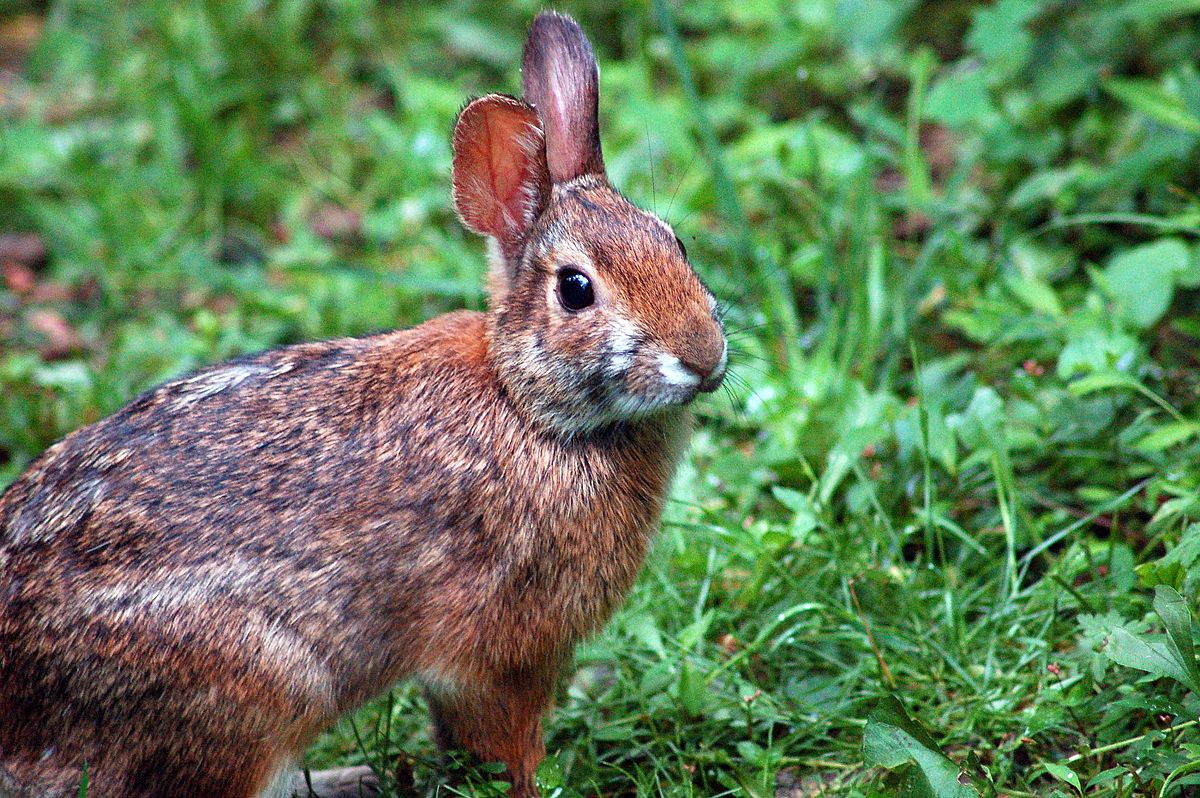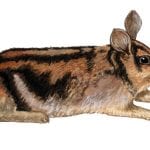Scientific Facts
| Common Name: | Appalachian Cottontail |
| Scientific Name: | Sylvilagus Obscurus |
| Life Span: | 1 year |
| Size: | 6.2 inches |
| Habitat: | Mountain and forested heath |
| Country of Origin: | Pennsylvania |
Physical Description
Appalachian Cottontails look relatively the same with the eastern cottontails. It is quite confusing to determine the difference between Appalachian Cottontails and eastern cottontails. The latter has white spots in their forehead. The Appalachian Cottontail, in particular, barely exhibits white spots; however, it exhibits a black spot in the middle of the ears. Appalachian Cottontail is relatively smaller in size. The length of their body is only around 6.2 inches. They weigh around 1.8 pounds.
Appalachian Cottontails have light-yellow brown fur, combined with black on the posterior. Their neck has a touch of red or brown patch. You will also notice that their abdominal part is generally white. They have short and fluffy tails, which are darker on their tip and white on their bottom.
Lifespan
Appalachian Cottontails have a limited lifespan. These creatures are said to live for around 1 year. These inhabitants are preserved because of their amazing productivity.
Eating Habits
Appalachian Cottontails greatly depend on appetizing forages in summer and spring. During winter seasons, these creatures would normally feed more on woody greenery.
Sleeping Habits
Different from the routine of humans in sleeping, Appalachian Cottontails sleep in the daytime. They are commonly seen active and busy doing their kinds of stuff during dusk and dawn. This is the reason why owners are advised to schedule their bonding with their pets in the early evening since it is not recommended to disturb these pets on their sleep.
Development and Reproduction
There is only limited information about the reproduction process of Appalachian Cottontails. Breeding starts in warm weather conditions. The breeding period of these creatures happens between February and October. The adult females are said to breed for 3 to 4 times every season and deliver 3 to 4 babies every litter. Before delivering their babies, the female Appalachian is said to start digging a nesting depression. She takes off a fur coming from her underbelly and collects leaves and berries to secure nest lining. The period of gestation ends roughly 28 days. Once the female Appalachian has already given birth, the babies shall inhibit n the nest through vegetation until they become self-reliant for around 3 to 4 weeks. The mother Appalachian will nourish her babies and stay at the nest two times a day to look after her babies. These creatures become mature reproductively after reaching the age of 1 to 2 months.
How to Breed
Determining the Sexes
Appalachian Cottontails of the same sexes look physically the same. Sexing is vital in determining the success of rearing. Thus, sexing methods are particularly important. One common procedure of determining the gender of an Appalachian Cottontail is through a surgical test.
Female Appalachian Cottontails are bigger compared to the male Appalachian Cottontails.
Courtship and Mating
It is perceived that there is a social ranking in Appalachian Cottontails, particularly when observing their mating habits. The male Appalachian Cottontail proclaims its domination by combatting to achieve mating superiority. These creatures also use their senses to look for their suitable mates. They may howl during mating.
The male Appalachian turns into breeding condition once winter is about to end because of the augmenting daylight and heightens in temperature.
Common Health Problems
Parasites
Ear mites, ticks, and fleas are common in Appalachian Cottontails. Ticks and fleas are easily noticed, while ear mites can only be noticed upon using an endoscope. Common indicators of ear mites are head shaking, scratching, and almost black residuals in ears. Ear mites must be treated immediately because they may cause ear infections.
Red Urine
Red urine is not a serious illness. It is very rampant in rabbits. Owners cannot be certain whether there is blood. A dipstick test may easily identify if there is real blood occurring in the urine.
Obesity
Obesity is a serious concern in rabbits. The biggest contributor to this concern is the inappropriate diet, excessive protein and carbohydrates, and lack of exercise. It is advised not to place the rabbit on a meticulous immediate diet. Unhurried alterations are ideal for helping the Appalachian Cottontail reduce weight. The reason behind the development of heart problems and fatty liver diseases is obesity.

Preventing Illnesses
The best way to handle an Appalachian Cottontail to prevent it from illnesses is to feed it with a proper diet. Rabbit pellets and fresh foods are ideal for this animal. Allow your pet to play as it serves as its physical activity and exercise. Being a responsible owner, you have to be cautious about the actual condition of your pet. If you notice any worrisome changes, it will be best if you refer your pet to a veterinarian to seek professional advice.
Behavior
Appalachian Cottontails are characterized as solitary. They are aggressive during dawn or at dusk. During the daytime, these creatures commonly evade their predators by shielding in burrows or under logs. These animals do not hibernate and are known to be active all year-round. These creatures have intense senses of sight, hearing, and smell. This helps them detect predators and abruptly respond to dangers. Mothers may make a groaning sound to warn their babies about the appearance of the predators.
These creatures have fast, jumping mobility to break away from their potential predators. Most of the time, these animals rush in a zigzag sequence to elude predators. A gliding kind of action, down to the surface with the ears retracted, can be done to refrain exposure. Moreover, these creatures may stay almost entirely static and quiet for around 15 minutes, even if nearly surrounded, to avoid exposure from predators.
Habitat
Enclosure
Appalachian Cottontails may be housed either indoors or outdoors. The cage should be appropriate in size. The rabbit should be able to move comfortably. Put a litter box in the corner of the cage. It would also be beneficial if you place some droppings inside the box.
Toys
Playtime is an essential part of your Appalachian Cottontail, being an augmentation to social interactions and exercise. Toys offer a channel for innate behaviors, and toys provide a sense of achievement and mental stimulation. Owners may choose to provide their pet some homemade toys such as cardboard boxes, oven-dried pine cones, phone books, and straw broom.
Diet
Appalachian Cottontails are known to be herbivores. They mainly eat on leaves, mountain laurel, Greenbriar, blackberry, twigs, and bark of trees like aspen, red maple, and black cherry. There are also times that these animals will feed on their feces because it is beneficial for the rabbits to consume some nutrients and vitamins which were not properly digested during the initial pass of digestion.
How to Care for Appalachian Cottontail
Raising an Appalachian Cottontail requires commitment from an owner. Handling requirements should be very detailed and should be accomplished to allow the pet to survive. Diet should be implemented in the best approach. The housing should be convenient for the rabbit and should give it a good place to rest. Moreover, exercise is also crucial for the pet. If you do not allow your pet to engage in physical interactions, there would be a chance that it may develop health issues.
Where to Get a Pet Appalachian Cottontail?
If you are thinking of getting an Appalachian Cottontail, the best option is to get it from a rabbit breeder. You may consider meeting a rabbit breeder first to check for an Appalachian Cottontail. He should be able to give you tips on how to properly raise this pet. You may also ask him about some things that are not recommended to the pet so you can avoid them.
Pet stores may also sell these pets; however, they are not ideally recommended because of their common environment. If you can find other sources for this rabbit, then that would be better.
FAQs
Are Appalachian Cottontails endangered?
Appalachian Cottontails are known to be almost endangered by the IUCN Red List. Their population has been diminishing, and it is not yet known why these breeds are restricted to great elevations.
How do I choose a pellet for my Appalachian Cottontail?
Rabbit pellets must be fresh and must be sufficiently rich in fiber. Do not buy pellets that are equivalent to 6 weeks of feeding time as they may become spoiled.
The weather is getting very hot, how should I manage my Appalachian Cottontail to keep it cooled?
See to it that you keep your pet away from the sun. You may set up a rotating fan that will sweep past your pet without directly blowing it. You may also dangle a wet towel over the cage so the installed fan shall whistle through the wet towel and manifest cooler air.
What are the ideal toys for Appalachian Cottontails?
There are wide selections when it comes to ideal toys for Appalachian Cottontails. Cardboard boxes and paper bags are great for chewing, scratching, and crawling inside. Rabbits enjoy them more if two or more entry points are going to the boxes. Batta balls are also great for these pets.


